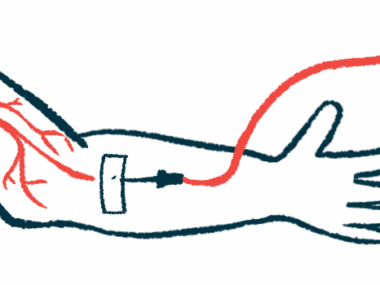Fasenra fares no worse than Nucala at keeping EGPA in remission
Nucala is the only approved therapy for this kind of ANCA-associated vasculitis
Written by |

AstraZeneca’s Fasenra (benralizumab) — approved for a rare type of asthma — does no worse than Nucala (mepolizumab) at keeping eosinophilic granulomatosis with polyangiitis (EGPA) in remission.
These are the first findings of the head-to-head Phase 3 MANDARA clinical trial (NCT04157348) that showed the study met its main goal. The trial is testing the safety and effectiveness of Fasenra in EGPA patients against GSK’s Nucala, the only approved therapy for this form of ANCA-associated vasculitis (AAV).
“The positive MANDARA trial results are exciting because patients with eosinophilic granulomatosis with polyangiitis today have limited treatment options, but face crippling symptoms, which can even be fatal if not treated,” Michael Wechsler, MD, the trial’s principal investigator, said in an AstraZeneca press release.
The company believes Fasenra may be a more convenient alternative since it’s given as a single subcutaneous (under-the-skin) injection once a month versus Nucala’s three separate subcutaneous injections once every four weeks.
AstraZeneca expects to present the full results from the trial, which began enrolling in early 2021, at an upcoming medical meeting. The findings will also be shared with regulatory agencies around the world as part of requests for Fasenra’s approval for EGPA.
Eosinophil-related asthma in EGPA
Like other types of AAV, EGPA is marked by damaging inflammation of small and medium blood vessels that can affect multiple organs and features the buildup of clumps of eosinophils, a type of immune cell.
Many EGPA patients have high numbers of eosinophils in the blood and half of them develop severe eosinophilic, or eosinophil-related, asthma as adults, with shortness of breath, wheezing, runny nose, or facial pain from sinusitis, an inflammation of the sinuses.
Corticosteroids are the mainstay treatment for EGPA, but are associated with severe side effects in the long term. Other immunosuppressive therapies are also commonly used.
Fasenra is an antibody that binds to the receptor protein of IL-5, a signaling molecule involved in the growth, maturation, and survival of eosinophils. By doing so, it also tags eosinophils for destruction by other immune cells, which is expected to help reduce inflammation.
It works similarly to Nucala, an approved add-on therapy for adults with EGPA in the U.S. and for people 6 and older with hard-to-treat EGPA in the European Union.
Fasenra is approved as an add-on maintenance treatment for severe eosinophilic asthma in the U.S., Europe, Japan, and other countries. AstraZeneca thinks it can also benefit EGPA patients and would require fewer injections than Nucala.
“Fasenra, which has a unique mechanism of action and directly targets eosinophils, can help [EGPA] patients achieve remission from the debilitating impacts of this inflammatory disease with a more convenient single monthly subcutaneous injection,” said Sharon Barr, executive vice president of biopharmaceuticals research and development at AstraZeneca.
How Fasenra compares to Nucala
The MANDARA trial enrolled 140 adults with relapsing or refractory (hard-to-treat) EGPA who were allowed to continue their standard treatment of oral corticosteroids, with or without stable immunosuppressive treatment.
The participants were randomly assigned to receive either a single dose of Fasenra (30 mg) or three separate doses of Nucala (100 mg) every four weeks for 52 weeks. Each dose was given as a subcutaneous injection.
The study’s main goal was to demonstrate that Fasenra wasn’t inferior to Nucala at promoting disease remission at both weeks 36 and 48 by assessing the proportion of patients in disease remission. Remission was defined as a Birmingham Vasculitis Activity Score (BVAS) of 0 and a corticosteroid dose equal to 4 mg/day or less.
Secondary goals included the duration of remission, time to first relapse, relapse rates, changes in disease severity and activity, and the proportion of patients able to reduce their corticosteroid dose. Other measures included side effects and the number of hospitalizations and emergency care visits related to EGPA.
Results announced so far showed the proportion of Fasenra-treated patients in remission was at least not inferior to the Nucala group.
“This trial demonstrates that a biologic medicine given in a single monthly injection could help patients achieve remission rates comparable to the current standard of care, adding to the importance of [Fasenra] as a potential treatment option for eosinophilic granulomatosis with polyangiitis,” Wechsler said.
Those who complete the one-year treatment will be able to enroll in an open-label extension, where all would receive Fasenra for a year.






